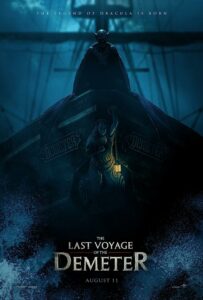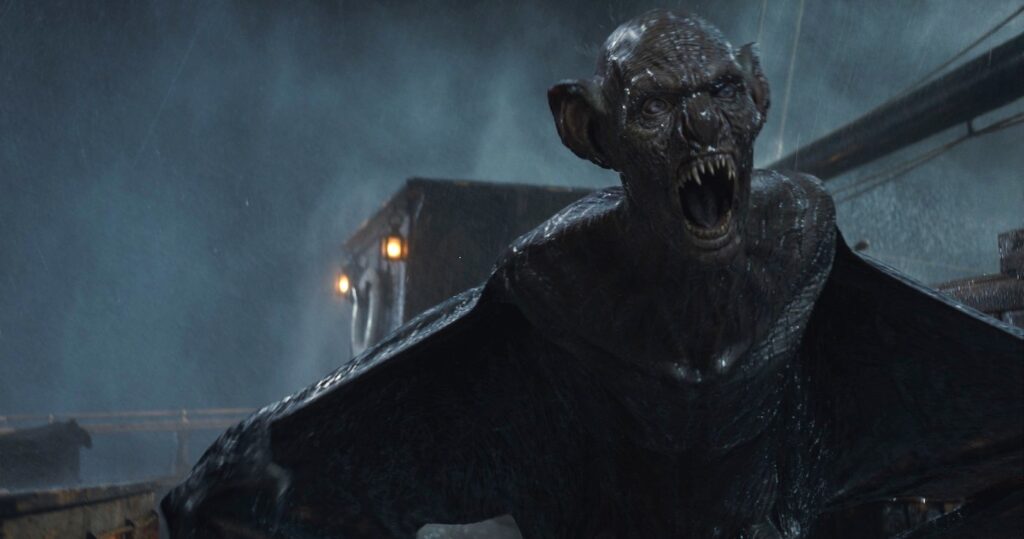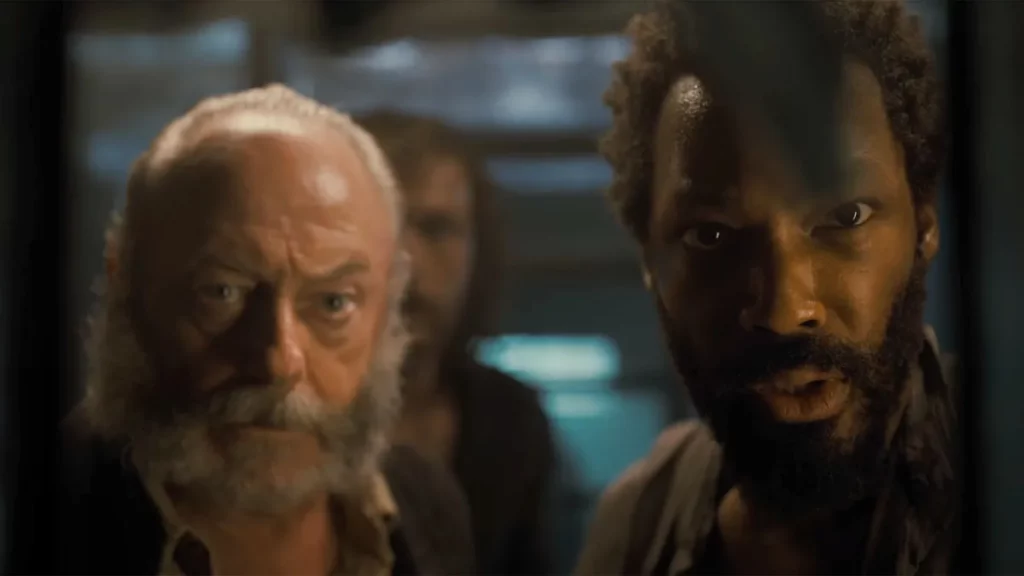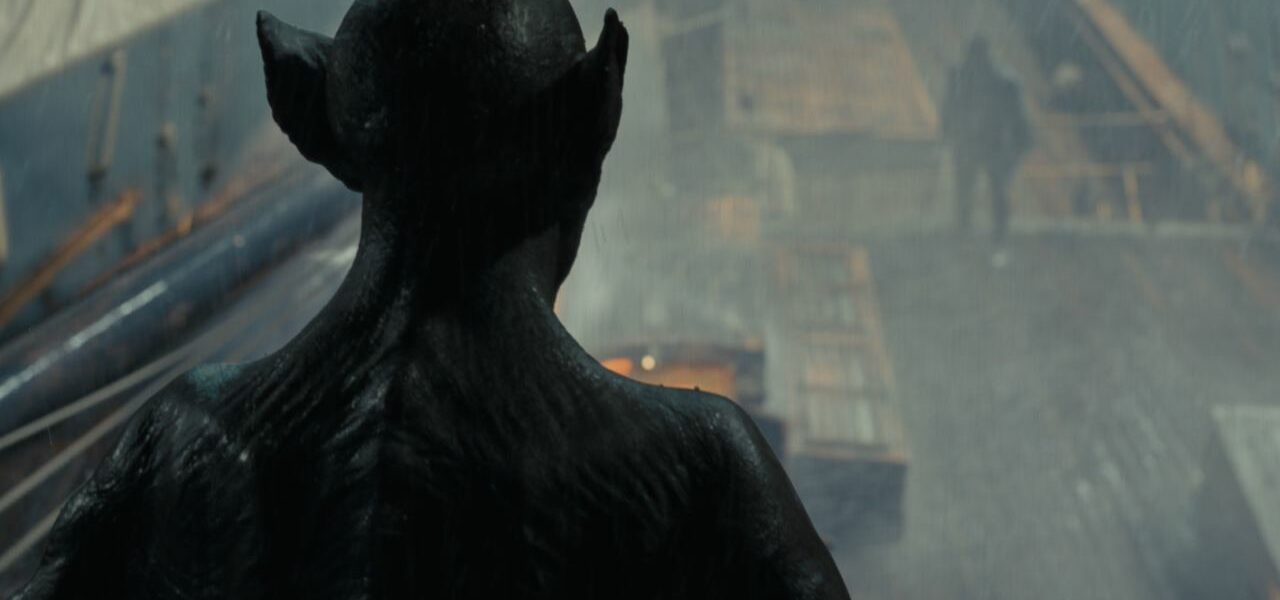WITH TEETH

Directed by André Øvredal
Starring Corey Hawkins, Liam Cunningham, Aisling Franciosi
Released August 11th, 2023
Rated R
There is a chapter in Bram Stoker’s epistolary novel Dracula titled The Captain’s Log, which details a ship, The Demeter, unknowingly transporting a dangerous, undead creature from Romania to England. Dread fills the ship as crew members start disappearing, and the chapter ends with the captain tying himself to the ship’s helm after his entire crew has vanished. The boat runs aground, the only survivor being the monster itself.
This sequence features briefly in the 1992 film Bram Stoker’s Dracula, adapted from Stoker’s novel by James V. Hart and directed by Francis Ford Coppola. Years later, a young man named Bragi Schut, Jr. was working in a model shop in Hollywood where he befriended the man who built the model of The Demeter for Coppola’s film. This encounter was the spark that led Schut to write a screenplay based on The Demeter’s ill-fated expedition. It took twenty years for the film to be made, with many writers taking a pass at the script, including James V. Hart. The final result penned by Zak Olkewicz, does indeed line up remarkably well with Francis Ford Coppola’s film, save for a final voiceover at the conclusion.
Perhaps the most inspired choice the film makes is in the design of the undead monster. This version of Dracula, portrayed by Javier Botet, harkens back to the makeup worn by Max Schreck as Count Orlok in F. W. Murnau’s 1922 classic Nosferatu. Botet is even credited as Dracula/Nosferatu in the credits. Throw in a bit of the creature design from Tobe Hooper’s 1979 television adaptation of Stephen King’s Salem’s Lot, and you’ve got a frightening human-sized bat monster, flying, shrieking, and thirsty for blood.

The Demeter is sailing from Romania to England (specifically Carfax Abbey) to deliver cargo for an anonymous charter. The cargo is many large, heavy crates, one bearing the seal of a dragon. The crew couldn’t care less what they are transporting, they just want to make the journey quickly to receive a bonus promised for expediency. Early on in their journey, one of the crates breaks open, spilling out dirt and revealing Anna, a young woman (Aisling Franciosi) clinging to life. The crew take her for a stowaway. The truth is much worse. Anna is nursed back to life through blood transfusions from Clemens (Corey Hawkins) a young black doctor who joined The Demeter’s crew just before they set sail. An educated man of color, Clemens struggles with the inequities of society. He considers it his life’s mission to divine answers to his questions about man’s inhumanity to man. Clemens struggles with the notion of evil. Though some on the boat are superstitious, Clemens dismisses the supernatural in favor of science. He wants the world to make sense.
Clemens immediately befriends Toby (Woody Norman), the grandson of the ship’s captain. Toby is a good-natured kid, clearly enjoying life at sea with his granddad and his loyal dog. I hope nothing bad happens to Toby and the dog. Clemens clashes with first mate Wojchek (David Dastmalchian), who cares more about making good time on the voyage than the safety of the people on board. Wojchek is held in high regard by Captain Elliot (Liam Cunningham), an old sea dog who is one voyage away from retirement. He plans to bequeath The Demeter to Wojchek after this passage, so he can provide Toby with a normal life on land. Liam Cunningham delivers a commanding, emotional performance that truly elevates the film, with Captain Elliot’s narration (seemingly lifted directly from Stoker’s book) powerfully setting a somber tone.

The Demeter looks great, a massive ship that has real personality. I credit director André Øvredal with making sure the audience always has a keen sense of the ship’s geography, so we have a good idea of where we are and where the monster is. The death scenes are not elaborate, mostly cloaked in shadows and rain. While we know that the people on board are doomed, the script gives most of them interesting enough backstories that we care when they are slaughtered by the vampire.
I appreciate that with a limited space and small crew, watching the vampire dispatch of everyone in twenty minutes wouldn’t give the audience enough time to eat their popcorn or finish their large blueberry Icee, but I wager this two-hour film would have felt more intense with a ninety-minute runtime. The pacing is far too slow, turning what should be a sense of dread into bouts with boredom.
The conclusion of the film concerns an encounter in a pub. This phenomenal ending is marred by a tacked-on voiceover that sets up a sequel. If one would remove that voiceover the film would be that much more chilling. But one poor choice doesn’t sink this ship. In the annals of Dracula on film, The Last Voyage of the Demeter stands as a slow, yet impressive entry…with teeth.


